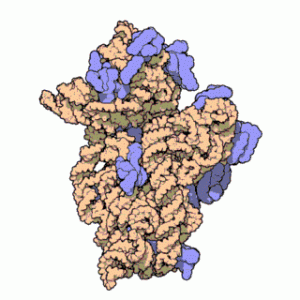Student Created Scientist Spotlights – Shining a Light to Encourage Diversity in STEM
Venkatraman Ramakrishnan – Puzzles: Solving of the 3D structure of a Prokaryotic Ribosome – could this lead to the development of new antibiotics?
Bardia Yasari and Zoë Soon

Venkatraman Ramakrishnan
To start off today’s topic, let’s learn more about Nobel Laureate, Venkatraman Ramakrishnan and his work on the discovery of the 3-D structure (atom-by-atom map) of the prokaryotic 30S ribosomal subunit., The 30S subunit is the small ribosomal subunit which binds to a large 50S subunit to form of the 70S prokaryotic ribosome. This ribosome is responsible for binding mRNA during the translation of mRNA into proteins in bacteria.
Born in India to a family of scientists, Dr. Ramakrishnan pursued a bachelor’s degree in Physics at Baroda University in Gujarat, India, and then continued his studies at the University of Ohio, where he earned his Ph.D. He then complete a post-doctorate in biology at the University of California, San Diego where he worked on ribosomes and chromatin. Having learned about chromatin and ribosomes, he became interested in making new discoveries in the field.
At the time, his colleague and fellow Nobel Laureate, Ada Yonath had initially pioneered x-ray cryo-crystallography (at -185°C) of different proteins and ribosomes including the large prokaryotic 50S subunit. The structure of the 50S ribosomal subunit, which harbors the peptidyl transferase center, revealed the surprising fact that the catalytic activity responsible for peptide bond formation is associated exclusively with RNA. Thus, the ribosome is in fact a ribozyme.
Venkatraman Ramakrishnan decided to get to work himself along with his colleagues Ada Yonath and Thomas A. Steitz in identifying the 3-D structure of the 30S ribosomal subunit which was no easy task. Ramakrishnan and his co-workers determined the structure of the Thermus Thermophilus 30S ribosomal subunit. In the same issue of the journal Nature, Steitz and his colleagues described the structure analysis of the 50S ribosomal subunit of the archaebacterium Haloarcula Marismortui. Both groups used multiple isomorphous substitutions with heavy metal derivatives to calculate the first molecular models of ribosomal subunits at 55.5 A resolution.
The technology at the time was quite limiting and made it hard to visualize the entire structure at a single time on a computer. With the development of more powerful computers near the end of their research, the team was able to add up the pieces of the 30S subunit together. They found out that the 30S subunit is comprised of a 16S rRNA, 19 proteins, and one polypeptide, so you can imagine how challenging it was to purify a large number of these 30S subunit complexes and have them form a crystal, which is necessary in order to determine their 3D structure using X-ray crystallography.

With the discovery of the structure of the ribosomal subunits, it is possible to produce specific synthetic antibiotics such as Tetracycline. Tetracycline can bind to the 30S subunit, which will block protein synthesis in bacteria and halt the translation step of mRNA into proteins. This antibiotic is valuable in combating bacterial infections, as tetracycline leads to bacterial death over time as the bacteria will no longer be able to replicate. Additionally this antibiotic is specific to bacterial ribosomal 30S subunits and does not bind human ribosomal subunits. Antibiotics can help cure or slow down damaging and/or deadly bacterial infections (e.g. bacterial pneumonia, endocarditis, sepsis). Currently, over 20 antibiotics target prokaryotic ribosomes.
Reference List:
– Animation by David S. Goodsell, RCSB Protein Data Bank – Molecule of the Month at the RCSB Protein Data Bank, Public Domain, https://commons.wikimedia.org/w/index.php?curid=2839678
– Bendale, H., & Jorvekar, C. (2021). Dr. Venki Ramakrishnan’s lecture on the discovery of the structure of ribosomes. The National Medical Journal of India, 34(2), 114. https://link.gale.com/apps/doc/A678269023/HRCA?u=ubcolumbia&sid=summon&xid=50b1d853
– Liljas, A. (2011). The ribosome story: An overview of structural studies of protein synthesis on the ribosome. Crystallography Reviews, 17(3), 205-223. https://doi.org/10.1080/0889311X.2011.587812
– U. Montan, (2009). Venkatraman Ramakrishnan The Bible Prize Winner of Chemistry in 2009. Nobel Prize Organization. https://www.nobelprize.org/prizes/chemistry/2009/ramakrishnan/facts/Yadugiri, V. T., & Ramakrishnan, V. (2010). Interview with Venkatraman Ramakrishnan.Current Science (Bangalore), 98(2), 136-139.
– https://www.nobelprize.org/womenwhochangedscience/stories/ada-yonath
*This Scientist Spotlight has just been published here (Oct. 2023): https://scientistspotlights.org/scientist/venkatraman-ramakrishnan/

